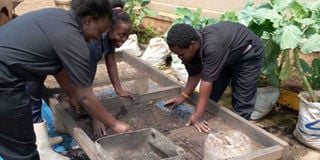How to make briquettes

Eva Birungi and her team sieving the charcoal dust while making briquettes. PHOTOs/COURTESY
What you need to know:
Briquettes are a slow-burning form of fuel that saves energy for home cooking and heating needs. Try out the recipes shared.
In a time where we are seeking to conserve the environment as well as cut back on costs, identifying alternative sources of cooking energy is important. One of these is briquettes.
Eva Birungi of Passion Farm explains that a briquette is a block of compressed coal dust, charcoal dust, sawdust, wood chips or biomass used as a fuel in stoves and boilers.
Ingredients
● The ingredients needed to make this energy source fall under the following categories:
● Heat fuel - wood charcoal, charcoal fines, mineral carbon, coal, and biomass
● Accelerants – sodium nitrate, waxes and sawdust
● Binder – starch, cement, kaolin, clay, and soil
Heat fuel
“The higher the percentage of heat fuel materials, the better the briquette. As such, ensure 80-90 per cent of the materials are heat fuel for better briquettes,” she says. Janet Kazairwe, a small-scale maker of briquettes uses cow dung, which is classified as biomass.
The materials should emit less dust. “For example, very fine charcoal dust/fines might originate from tree leaves with lots of dust and soil, giving you lots of ashes. Larger fines are better and one just needs to crush them to an appropriate size,” Birungi shares.

Accelerants
Unlike charcoal, briquettes need accelerants to burn faster, because of the structural difference. “While charcoal is lump, briquettes are compact and thus may not sufficiently absorb oxygen for faster combustion. Accelerants should comprise about 10–20 per cent of the material,” she explains. However, uncarbonised sawdust will make your briquettes emit a lot of smoke. “To reduce the smoke emitted, partly ferment your sawdust for about five days by soaking it in water,” she says.
Briquette binders
Unlike clay, charcoal dust, one of the ingredients of the briquettes, is without plasticity so moulding it into a shape without adding a binding material is impossible. Therefore, Birungi says an agglomerating material is added to the dust, and then pressure is applied to the mixture to form a briquette.
“The best binder has proven to be starch and while any starch will do, cassava is preferred. You will need about five to seven per cent starch to make briquettes. For example, a 45-kilogramme bag of charcoal fines will need two to three kilogrammes of starch,” she says.
Another option is mashed newsprint/waste paper pulp, not forgetting molasses, cement, clay, and tar.
Procedures in briquette making
To make charcoal briquettes, test different recipes repeatedly until you find one that works for you.
Recipe #1
● 10 kg charcoal dust/fines
● 0.3 kg cassava starch
Recipe #2
● 40 kg charcoal dust/fines
● 4 kg sawdust
● 2.5kg starch
Recipe #3
● 10 kg charcoal dust/fines
● 5 kg saw dust
● 1 kg cassava starch
● 0.5 kg limestone
Mixing method
Well-mixed ingredients will result in a better briquette compared to poorly mixed ones. Birungi uses a machine and she attests that it gives better results than when one uses hands.
Procedure
According to the recipe you have chosen, Birungi says you should:
● Ferment the sawdust or other accelerators (carbonise) as mentioned.
● Sieve the mixture to remove the big particles and the poorly carbonised materials in order to have a fine output
● Then mix charcoal fines, carbonised mixture, clay and water
● Mould to your desired shapes or use a briquette machine for moulding
● Spread them out under bright sunshine let dry very well
Janet Kazairwe, works manually with cow dung in a big basin or on a clean floor (if it is bulky). Thereafter, she adds cassava flour and anthill soil. “All these must be sieved to remove any big particles. Clay is better than anthill soil because it holds the mixture better. I grind the big particles of charcoal dust for an even feel,” she explains. If the mixture is too hard, Kazairwe adds water until it is soft enough to make balls for charcoal.
Thereafter, she spreads them out to dry on a sack laid on the ground. “With lots of sunshine, they dry within three days,” Kazairwe shares.
Uses of charcoal briquettes
●Charcoal briquettes are a slow cooking type of fuel hence good for burning in the preparation of foods that consume a lot of fuel such as dry beans, matooke.
● brooding
● warming in cold houses
Advantages of briquettes
● Just a few of them needed to cook foods that take long to get ready.
● They can work alongside charcoal to reduce its consumption because briquettes are reusable if they are still hard or intact.
Biomass briquette making is gaining in popularity as the development of renewable energy continues to become popular. Setting up a biomass waste recycling plant not only helps you to make a good profit but is also protection for the world’s environment today and in the future.
Fillers
These are substances added to briquettes to increase the weight, density, or volume of the briquettes but add no energy value. “Cassava flour and cement work well here. These prolong the burning period of briquettes. However, excess use makes the briquettes of a poor quality,” Birungi says.





